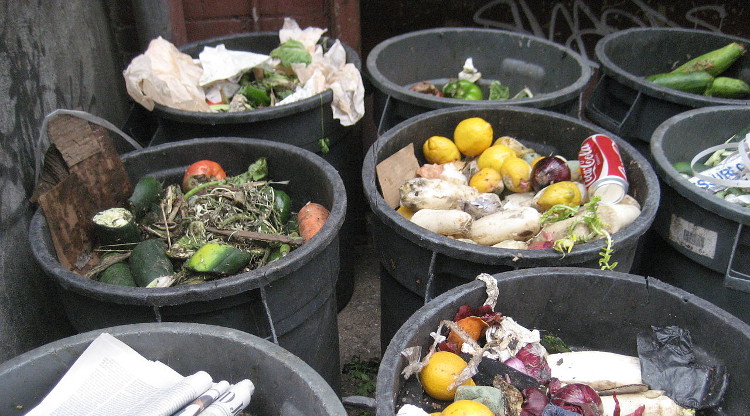Guijie is an abrasive sight no matter what time it is. Throngs of visitors crowd the sidewalks. Street vendors sell kitschy mementos. Babies wail, parents shout, couples canoodle.
As a resident of the famous restaurant street, I’ve often found myself strolling its rowdy blocks, succumbing to existential rancor at the sight of tourists with selfie sticks shucking sunflower seeds, while basked in a garish neon glow.
To be fair, I’ve had a decent meal or two within these joints. (Hot pot’s hard to mess up.) But my desire to eat therein has been sullied by the one thing that, as a local, I’ve noticed most: waste.
Walk Guijie often enough, and you’ll notice a strange liquid gathering along the curbs. It is brownish, smells like rotten food, and is littered with bits of chili pepper and crayfish. The sludge is not just there after it rains. It’s a permanent fixture, as dependable a presence as the megaphoned hawkers advertising their Sichuan delights.
Try as they might, street sweepers can’t keep this stuff away. Day and night, this sticky sludge pools on the sidewalk. Its source? The street’s huge, overflowing trashcans – stuffed full with kitchen waste. But it’s more than something to look out for when you’re wearing flip-flops. It’s a symbol of China’s massive food waste problem, as well as the consumers and restaurants that play into it.
Food waste is not a new problem. Nor is it one that’s unique to China. According to the UN’s Food and Agriculture Organization (FAO), approximately one-third of all food produced for human consumption globally is lost or wasted. That’s 1.3 billion tons per year.
That said, China is a special case. Unique economic and cultural factors are making food waste in Beijing a particularly Chinese phenomenon.
“Waste is a rather modern occurrence in highly industrialized areas,” says Robert van Otterdijk, a food technologist and researcher with the FAO. “It’s when food is fit for consumption, but lost by consumers, shoppers and retailers. It’s intentional discarding of good food, and it’s a behavioral problem.”
Just a few decades ago, food waste wasn’t much of an issue, as China had yet to become what van Otterdijk calls a “highly industrialized area.” Not to mention the fact that it is a mere 60 years since the country was in the grip of famine.
Common sense dictates that less food would be wasted in times of scarcity, and the experts back this up.
“Overall, on a per-capita basis, much more food is wasted in the industrialized world than in developing countries,” reads an FAO report. “In medium- and high-income countries food is, to a significant extent, wasted at the consumption stage, meaning that it is discarded even if it is still suitable for human consumption.”
While the FAO’s report covers large-scale food systems, its lessons are applicable to the individuals within them.
“At the consumer household level, in poorer areas, food waste is minimum. But in rich areas, it’s huge,” says van Otterdijk.
Because income directly correlates to the amount of food wastage (and because there’s such a sharp difference between the rich and the poor in China), food wastage from family to family here differ greatly.
“I don’t waste food in my house,” says Xu Ming, a man selling pigs' feet from a stall near Dongzhimen. “Food waste is different between the classes. Common people like us don’t waste food.”
He makes a compelling point. While Xu prepares only enough pigs’ feet to sell each day, and closes as soon as he sells out, his counterparts on the other end of China’s socioeconomic stratum take a different approach.
For Xu, the other end of that stratum is on the other end of the street. As he speaks, a parade of restaurant workers exit a nearby restaurant, each with a large trash can labeled “kitchen waste” in tow. The workers drag their bins, dump them into the waiting trash truck and then return to the kitchen to grab more. A fresh stream of sticky sludge trails behind them.
To those in the top reaches of Chinese society, trash is merely the lesser-seen underbelly of a flourishing culture of banqueting. For centuries, banquets have been an important part of upper-class society. Emperors and members of the imperial court banqueted, businessmen and their clients banqueted, and, in news that has made headlines more recently, government officials banqueted – lavishly.
The cultural weight of the banquet is not to be underestimated. As Chinese gastronomy expert Fuchsia Dunlop writes on her website: “Banquets in China are about so many things besides food, including, depending on the occasions, social relationships, business, face, hierarchy, sycophancy, bribery, festivity.”
According to a 2011 Global Times report, Chinese government officials spent RMB600 billion annually on alcohol – or the same amount as China’s officially declared annual defense expenditure.
They still do, only to a lesser extent. In 2013, the Chinese Government rolled out a ‘Clean Your Plate’ campaign, aimed at cutting back food waste, consisting primarily of commercials on CCTV.
After all, it’s not all doom and gloom for China’s food waste problems. Xi Jinping has made headlines for Party anti-corruption reforms, and one weed he sought to eradicate was excessive – and wasteful – government banquets.
Still, China’s problem is rampant, and the country has a long way to go in order to make real progress toward eliminating food waste.
And as a country whose economy is developing at breakneck speed, China faces a special challenge, says van Otterdijk.
“People can afford more, and they couldn’t before. So they go buy things without needing them.”
Van Otterdijk and his colleagues cite recent programs in Europe and Asia that have already made a difference by enouraging consumers to “consider consumption in a different way.”
But perhaps Wang Bingquan, who runs a local supermarket, explains it in the most pragmatic way.
“For us it’s a matter of money,” he says. “The more we throw out, the less we earn.”






















0 User Comments